Three Sovereigns and Five Emperors
The Three Sovereigns and Five Emperors were two groups of mythological rulers or deities in ancient northern China. The Three Sovereigns lived before The Five Emperors, who have been assigned dates in a period from circa 2852 BC to 2070 BC. Today they may be considered culture heroes.[1]
Era of the Three Sovereigns and Five Emperors 三皇五帝 | |||||||||
|---|---|---|---|---|---|---|---|---|---|
| c. 2852 BCE–c. 2070 BCE | |||||||||
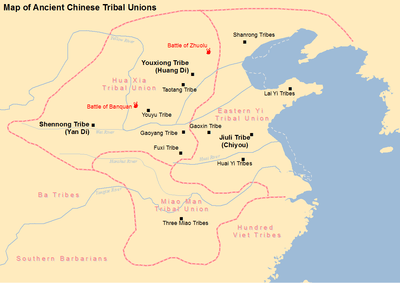 | |||||||||
| Status | Legendary Kingdom | ||||||||
| Capital | Qufu | ||||||||
| Common languages | Old Chinese, Sinitic Languages | ||||||||
| Government | Tribal kingship, Chiefdom | ||||||||
| Di | |||||||||
• 2698–2598 BCE | Huangdi | ||||||||
• 2514–2436 BCE | Zhuanxu | ||||||||
• 2436–2366 BCE | Kù | ||||||||
• 2366–2358 BCE | Zhì | ||||||||
• 2356–2255 BCE | Yáo | ||||||||
• 2255–2208 BCE | Shùn | ||||||||
| History | |||||||||
• Established | c. 2852 BCE | ||||||||
• Disestablished | c. 2070 BCE | ||||||||
| |||||||||
| Three Sovereigns and Five Emperors | |||||||||||||||
|---|---|---|---|---|---|---|---|---|---|---|---|---|---|---|---|
| Chinese | 三皇五帝 | ||||||||||||||
| |||||||||||||||
 | ||||||||
|---|---|---|---|---|---|---|---|---|
| ANCIENT | ||||||||
| Neolithic c. 8500 – c. 2070 BC | ||||||||
| Xia c. 2070 – c. 1600 BC | ||||||||
| Shang c. 1600 – c. 1046 BC | ||||||||
| Zhou c. 1046 – 256 BC | ||||||||
| Western Zhou | ||||||||
| Eastern Zhou | ||||||||
| Spring and Autumn | ||||||||
| Warring States | ||||||||
| IMPERIAL | ||||||||
| Qin 221–207 BC | ||||||||
| Han 202 BC – 220 AD | ||||||||
| Western Han | ||||||||
| Xin | ||||||||
| Eastern Han | ||||||||
| Three Kingdoms 220–280 | ||||||||
| Wei, Shu and Wu | ||||||||
| Jin 266–420 | ||||||||
| Western Jin | ||||||||
| Eastern Jin | Sixteen Kingdoms | |||||||
| Northern and Southern dynasties 420–589 | ||||||||
| Sui 581–618 | ||||||||
| Tang 618–907 | ||||||||
| (Wu Zhou 690–705) | ||||||||
| Five Dynasties and Ten Kingdoms 907–979 |
Liao 916–1125 | |||||||
| Song 960–1279 | ||||||||
| Northern Song | Western Xia | |||||||
| Southern Song | Jin | Western Liao | ||||||
| Yuan 1271–1368 | ||||||||
| Ming 1368–1644 | ||||||||
| Qing 1636–1912 | ||||||||
| MODERN | ||||||||
| Republic of China on mainland 1912–1949 | ||||||||
| People's Republic of China 1949–present | ||||||||
| Republic of China on Taiwan 1949–present | ||||||||
The dates of these mythological figures may be fictitious, but according to some accounts and reconstructions, they preceded the Xia Dynasty.[2]
Description
The Three Sovereigns, sometimes known as the Three August Ones, were said to be god-kings, demigods or god emperors[3] who used their abilities to improve the lives of their people and impart to them essential skills and knowledge. The Five Emperors are portrayed as exemplary sages who possessed great moral character and lived to a great age and ruled over a period of great peace. The Three Sovereigns are ascribed various identities in different Chinese historical texts.
These kings are said to have helped introduce the use of fire, taught people how to build houses and invented farming. The Yellow Emperor's wife is credited with the invention of silk culture. The discovery of medicine, the invention of the calendar and Chinese script are also credited to the kings. After their era, Yu the Great founded the Xia Dynasty.[2]
According to a modern theory with roots in the late 19th century, the Yellow Emperor is supposedly the ancestor of the Huaxia people.[4] The Mausoleum of the Yellow Emperor was established in Shaanxi Province to commemorate the ancestry legend.[4]
The Chinese word for emperor, huángdì (皇帝), derives from this, as the first user of this title Qin Shi Huang considered his reunion of all of the lands of the former Kingdom of Zhou to be greater than even the Three Sovereigns and Five Emperors.
Shi
A related concept appears in the legend of the Four shi (四氏) who took part in creating the world. The four members are Youchao-shi (有巢氏), Suiren-shi (燧人氏), Fuxi-shi (伏羲氏), and Shennong-shi (神農氏). The list sometimes extends to one more member being Nüwa-shi (女媧氏), making Five shi (五氏).[5] Four of these five names appear in different lists of the Three Sovereigns. shi(氏) is the meaning of clan or tribe in china, so none of them are a single person in prehistoric times.
There is a saying that the Three Sovereigns are Suiren-shi (燧人氏), Youchao-shi (有巢氏), Shennong-shi (神農氏). The Suiren taught people to drill wood for fire so people could easily migrate. The Youchao taught people to build houses with wood, so that people could leave caves to expand into the plains. After the number of people grew, Shennong tried a variety of grasses to find suitable cereals to solve people's food problems. The tribes also used the sovereigns' respective contributions as the name of the tribes.
Variations
Depending on the source, there are many variations of who classifies as the Three Sovereigns or the Five Emperors. There are at least six to seven known variations.[6] Many of the sources listed below were written in much later periods, centuries and even millennia after the supposed existence of these figures, and instead of historical fact, they may reflect a desire in later time periods to create a fictitious ancestry traceable to ancient culture heroes. The Emperors were asserted as ancestors of the Xia, Shang, and Zhou dynasties.[7] The following appear in different groupings of the Three Sovereigns: Fuxi (伏羲), Nüwa (女媧), Shennong (神農), Suiren (燧人), Zhurong (祝融), Gong Gong (共工), Heavenly Sovereign (天皇), Earthly Sovereign (地皇), Tai Sovereign (泰皇), Human Sovereign (人皇), and even the Yellow Emperor (黄帝).
The following appear in different groupings of the Five Emperors: Yellow Emperor (黃帝), Zhuanxu (顓頊), Emperor Ku (嚳), Emperor Yao (堯), Emperor Shun (舜), Shaohao (少昊), Taihao (太昊), and Yan Emperor (炎帝).
| Source | Date of source | Three Sovereigns | Five Emperors |
|---|---|---|---|
| Records of the Grand Historian (史記) edition by Sima Qian[6] |
94 BCE | Heavenly Sovereign (天皇) or Fu Xi (伏羲) Earthly Sovereign (地皇) or Nüwa (女媧) Tai Sovereign (泰皇) or Shennong (神農) |
Yellow Emperor (黃帝) Zhuanxu (顓頊) Emperor Ku (嚳) Emperor Yao (堯) Emperor Shun (舜) |
| Sovereign series (帝王世系)[6] | Fu Xi (伏羲) Shennong (神農) Yellow Emperor (黃帝) |
Shaohao (少昊) Zhuanxu (顓頊) Emperor Ku (嚳) Emperor Yao (堯) Emperor Shun (舜) | |
| Shiben[6] | 475-221 BCE (the Warring States period) according to the Book of Han (111 CE) | Fu Xi (伏羲) Shennong (神農) Yellow Emperor (黃帝) |
|
| Baihu Tongyi (白虎通義)[6] | Fu Xi (伏羲) Shennong (神農) Zhurong (祝融) or Suiren (燧人) |
||
| Fengsu TongYi (風俗通義)[6] | 195 CE | Fu Xi (伏羲) Nüwa (女媧) Shennong (神農) |
|
| Yiwen Leiju (藝文類聚)[6] | 624 CE | Heavenly Sovereign (天皇) Earthly Sovereign (地皇) Human Sovereign (人皇) |
|
| Tongjian Waiji (通鑑外紀) | Fu Xi (伏羲) Shennong (神農) Gong Gong (共工) |
||
| Chunqiu yundou shu (春秋運斗樞) Chunqiu yuanming bao (春秋元命苞) |
Fu Xi (伏羲) Nüwa (女媧) Shennong (神農) |
||
| Shangshu dazhuan (尚書大傳) | Fu Xi (伏羲) Shennong (神農) Suiren (燧人) |
||
| Diwang shiji (帝王世紀) |
Fu Xi (伏羲) |
||
| I Ching (易經)[6] | 800s BCE | Taihao (太昊) Yan Emperor (炎帝) Yellow Emperor (黃帝) Emperor Yao (堯) Emperor Shun (舜) | |
| Comments of a Recluse, Qianfulun (潛夫論)[8] | Taihao (太昊) Yan Emperor (炎帝) Yellow Emperor (黃帝) Shaohao (少昊) Zhuanxu (顓頊) | ||
| Zizhi tongjian waiji, (資治通鑒外紀)[8] | Yellow Emperor (黃帝) Shaohao (少昊) Zhuanxu (顓頊) Emperor Ku (嚳) Emperor Yao (堯) | ||
Family tree of ancient Five Emperors
| Family tree of ancient Five Emperors | |||||||||||||||||||||||||||||||||||||||||||||||||||||||||||||||||||||||||||||||||||||||||||||||||||||||||||||||||||||||||||||||||||||||||||||||||||||||||||||||||||||||||||||||||||||||||||||||||||||||||||||||||||||||||||||||||||||||||||||||||||||||||||||||||||||||||||||||||||||||||||||||||||||||||||||||||||||||||||||||||||||||||||||||||||||||||||||||||||||||||||||||||||||||||||||||||||||||||||||||||||||||||||||||||||||||||||||||||||||||||||||||||||||||||||||||||||||||||||||||||||||||||||||||||||||||||||||||||||||||||||||||||||||||||||||||||||||||||||||||||||||||||||||||||||||||||||||||||||||||||||||||||||||||||||||||||||||||||||||||||||||||||||||||||||||||||||||||||||||||||||||||||||||||||||||||||||||||||||||||||||||||||||||||||||||||||||||||||||||||||||||||||||||||||||||||||||||||||||||||||||||||||||||||||||||||||||||||||||||||||||||||||||||||||||||||||||||||||||||||||||||||||||||||||||||||||||||||||||||||||||||||||||||||||||||||||||||||||||||||||||||||||||||||||||||||||||||||||||||||
|---|---|---|---|---|---|---|---|---|---|---|---|---|---|---|---|---|---|---|---|---|---|---|---|---|---|---|---|---|---|---|---|---|---|---|---|---|---|---|---|---|---|---|---|---|---|---|---|---|---|---|---|---|---|---|---|---|---|---|---|---|---|---|---|---|---|---|---|---|---|---|---|---|---|---|---|---|---|---|---|---|---|---|---|---|---|---|---|---|---|---|---|---|---|---|---|---|---|---|---|---|---|---|---|---|---|---|---|---|---|---|---|---|---|---|---|---|---|---|---|---|---|---|---|---|---|---|---|---|---|---|---|---|---|---|---|---|---|---|---|---|---|---|---|---|---|---|---|---|---|---|---|---|---|---|---|---|---|---|---|---|---|---|---|---|---|---|---|---|---|---|---|---|---|---|---|---|---|---|---|---|---|---|---|---|---|---|---|---|---|---|---|---|---|---|---|---|---|---|---|---|---|---|---|---|---|---|---|---|---|---|---|---|---|---|---|---|---|---|---|---|---|---|---|---|---|---|---|---|---|---|---|---|---|---|---|---|---|---|---|---|---|---|---|---|---|---|---|---|---|---|---|---|---|---|---|---|---|---|---|---|---|---|---|---|---|---|---|---|---|---|---|---|---|---|---|---|---|---|---|---|---|---|---|---|---|---|---|---|---|---|---|---|---|---|---|---|---|---|---|---|---|---|---|---|---|---|---|---|---|---|---|---|---|---|---|---|---|---|---|---|---|---|---|---|---|---|---|---|---|---|---|---|---|---|---|---|---|---|---|---|---|---|---|---|---|---|---|---|---|---|---|---|---|---|---|---|---|---|---|---|---|---|---|---|---|---|---|---|---|---|---|---|---|---|---|---|---|---|---|---|---|---|---|---|---|---|---|---|---|---|---|---|---|---|---|---|---|---|---|---|---|---|---|---|---|---|---|---|---|---|---|---|---|---|---|---|---|---|---|---|---|---|---|---|---|---|---|---|---|---|---|---|---|---|---|---|---|---|---|---|---|---|---|---|---|---|---|---|---|---|---|---|---|---|---|---|---|---|---|---|---|---|---|---|---|---|---|---|---|---|---|---|---|---|---|---|---|---|---|---|---|---|---|---|---|---|---|---|---|---|---|---|---|---|---|---|---|---|---|---|---|---|---|---|---|---|---|---|---|---|---|---|---|---|---|---|---|---|---|---|---|---|---|---|---|---|---|---|---|---|---|---|---|---|---|---|---|---|---|---|---|---|---|---|---|---|---|---|---|---|---|---|---|---|---|---|---|---|---|---|---|---|---|---|---|---|---|---|---|---|---|---|---|---|---|---|---|---|---|---|---|---|---|---|---|---|---|---|---|---|---|---|---|---|---|---|---|---|---|---|---|---|---|---|---|---|---|---|---|---|---|---|---|---|---|---|---|---|---|---|---|---|---|---|---|---|---|---|---|---|---|---|---|---|---|---|---|---|---|---|---|---|---|---|---|---|---|---|---|---|---|---|---|---|---|---|---|---|---|---|---|---|---|---|---|---|---|---|---|---|---|---|---|---|---|---|---|---|---|---|---|---|---|---|---|---|---|---|---|---|---|---|---|---|---|---|---|---|---|---|---|---|---|---|---|---|---|---|---|---|---|---|---|---|---|---|---|---|---|---|---|---|---|---|---|---|---|---|---|---|---|---|---|---|---|---|---|---|---|---|---|---|---|---|---|---|---|---|---|---|---|---|---|---|---|---|---|---|---|---|---|---|---|---|---|---|---|---|---|---|---|---|---|---|---|---|---|---|---|---|---|---|---|---|---|---|---|---|---|---|---|---|---|---|---|---|---|---|---|---|---|---|---|---|---|---|---|---|---|---|---|---|---|---|---|---|---|---|---|---|---|---|---|---|---|---|---|---|---|---|---|---|---|---|---|---|---|---|---|---|---|---|---|---|---|---|---|---|---|---|---|---|---|---|---|---|---|---|---|---|---|---|---|---|---|---|---|---|---|---|---|---|---|---|---|---|---|---|---|---|---|---|---|---|---|---|---|---|---|---|---|---|---|---|---|---|---|---|---|---|---|---|---|---|---|---|---|---|---|---|---|---|---|---|---|---|---|---|---|---|---|---|---|---|---|---|---|---|---|---|---|---|---|---|---|---|---|---|---|---|---|---|---|---|---|---|---|---|---|---|---|---|---|---|---|---|---|---|---|---|---|---|---|---|---|---|---|---|---|---|---|---|---|---|---|---|---|---|---|---|---|---|---|---|---|---|---|---|---|---|---|---|---|---|---|---|---|---|---|
| |||||||||||||||||||||||||||||||||||||||||||||||||||||||||||||||||||||||||||||||||||||||||||||||||||||||||||||||||||||||||||||||||||||||||||||||||||||||||||||||||||||||||||||||||||||||||||||||||||||||||||||||||||||||||||||||||||||||||||||||||||||||||||||||||||||||||||||||||||||||||||||||||||||||||||||||||||||||||||||||||||||||||||||||||||||||||||||||||||||||||||||||||||||||||||||||||||||||||||||||||||||||||||||||||||||||||||||||||||||||||||||||||||||||||||||||||||||||||||||||||||||||||||||||||||||||||||||||||||||||||||||||||||||||||||||||||||||||||||||||||||||||||||||||||||||||||||||||||||||||||||||||||||||||||||||||||||||||||||||||||||||||||||||||||||||||||||||||||||||||||||||||||||||||||||||||||||||||||||||||||||||||||||||||||||||||||||||||||||||||||||||||||||||||||||||||||||||||||||||||||||||||||||||||||||||||||||||||||||||||||||||||||||||||||||||||||||||||||||||||||||||||||||||||||||||||||||||||||||||||||||||||||||||||||||||||||||||||||||||||||||||||||||||||||||||||||||||||||||||||
Gallery

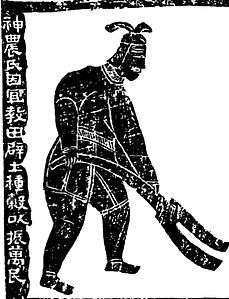

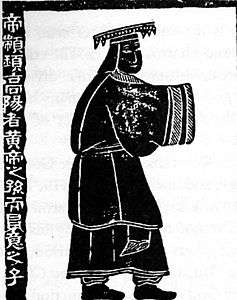
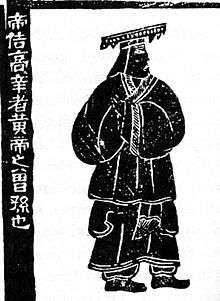
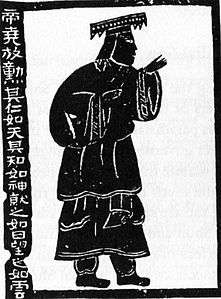
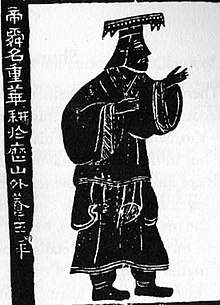
 Chi You
Chi You
See also
References
- Hucker, Charles (1995). China's Imperial Past: An Introduction to Chinese History and Culture. Stanford University Press. p. 22. ISBN 9780804723534.
- Morton, W. Scott; Lewis, Charlton M. (2005). China: its history and culture. McGraw-Hill. p. 14. ISBN 978-0-07-141279-7.
- Eliade, Mircea; Adams, Charles J., eds. (1987). The Encyclopedia of religion. 9, Liu-Mith. Macmillan. p. 133. Missing or empty
|title=(help) - 王恆偉 (2005). Zhongguo li shi jiang tang #1 Yuan gu zhi Chun Qiu 中國歷史講堂 #1 遠古至春秋 [Chinese History Lectures #1: Ancient times to Spring and Autumn period]. 中華書局. p. 13. ISBN 962-8885-24-3.
- 王恆偉 (2005). Zhongguo li shi jiang tang #1 Yuan gu zhi Chun Qiu 中國歷史講堂 #1 遠古至春秋 [Chinese History Lectures #1: Ancient times to Spring and Autumn period]. 中華書局. pp. 4–7. ISBN 962-8885-24-3.
- 劉煒 (2002). Yuan shi she hui 中华文明传真 [Chinese civilization in a new light]. Commercial press publishing. p. 142. ISBN 962-07-5314-3.
- Soothill, William Edward; Hosie, Dorothea Lady; Hudson, G. F. (2002). The Hall of Light: A Study of Early Chinese Kingship. James Clarke & Co. pp. 146–. ISBN 978-0-227-17123-3.
- Ulrich Theobald. "Sanhuang wudi 三皇五帝, the Three Augusts and Five Emperors". ChinaKnowledge.de.
- Sima Qian, Records of the Grand Historian
Further reading
- . Translated by Allen, Herbert J. "Ssŭma Ch'ien's Historical Records, Introductory Chapter". Journal of the Royal Asiatic Society. 26 (2): 269–295. 1894. doi:10.1017/S0035869X00143916.
- "The Annals of the Bamboo Books: The reigns of Huang-te, Che, Chuen-heuh and Hëen-Yuen; The reigns of Yaou and Shun". The Chinese Classics, volume 3, part 1. Translated by Legge, James. 1865. pp. 108–116.
| Preceded by None known |
Dynasties in Chinese history 2852–2205 BC |
Succeeded by Xia dynasty |